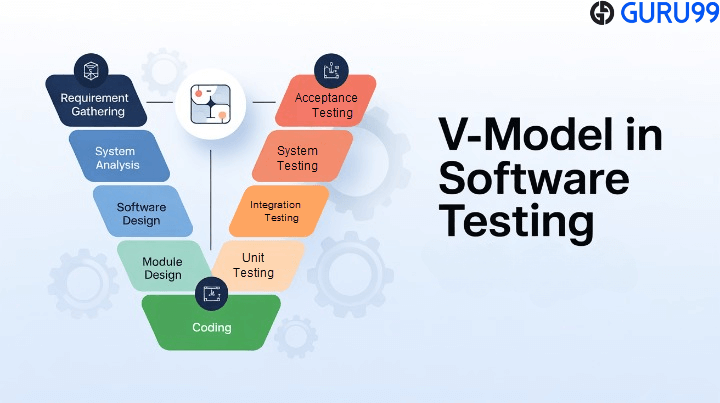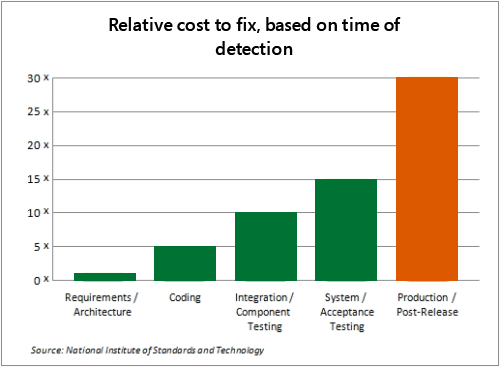V-Model in Software Testing
What is V-Model in Software Testing?
The V-Model is a software development methodology that pairs each development activity with a corresponding testing activity. It is also known as the Verification and Validation model. The structure resembles the letter “V,” where the left side represents development activities, and the right side represents testing activities. This model extends the traditional Waterfall model by addressing its weaknesses, particularly the late focus on testing.
In the V-Model, testing is planned alongside development, ensuring early defect detection and clear traceability between requirements and test cases. It is widely used in industries where reliability, compliance, and thorough documentation are critical, such as healthcare, finance, and aviation.
Video to understand the V Model in Software Engineering
Click here if the video is not accessible
Example To Understand the V Model
Suppose you are assigned a task to develop a custom software for a client. Now, irrespective of your technical background, try to make an educated guess about the sequence of steps you will follow to achieve the task.
The correct sequence would be.
| Phases of Software Development | Activities performed in each stage |
|---|---|
| Requirement Gathering stage | Gather as much information as possible about the details & specifications of the desired software from the client. This is nothing but the Requirements gathering stage. |
| Design Stage | Plan the programming language like Java, PHP, .net; database like Oracle, MySQL, etc. Which would be suited for the project, also some high-level functions & architecture. |
| Build Stage | After the design stage, it is build stage, that is nothing but actually code the software |
| Test Stage | Next, you test the software to verify that it is built as per the specifications are given by the client. |
| Deployment stage | Deploy the application in the respective environment |
| Maintenance stage | Once your system is ready to use, you may require to change the code later on as per customer request |
All these levels constitute the waterfall method of the software development lifecycle.
Why V-Model? (Problems with Waterfall)
The traditional Waterfall model focuses on sequential stages, with testing only after development is complete. This approach often leads to costly and time-consuming fixes when errors are discovered late. Common problems include:
- Late discovery of defects.
- Lack of requirements validation until the final stage.
- Higher cost of defect fixing.
- Risk of delivering a product misaligned with user expectations.
The V-Model solves these issues by embedding testing throughout the development cycle, reducing risks and improving software reliability.
Also, the costs of fixing a defect increase across the development lifecycle. The earlier in life cycle a defect is detected, the cheaper it is to fix it. As they say, “A stitch in time saves nine.”
Solution: The V Model
To address this concern, the V model of testing was developed, where for every phase in the Development life cycle, there is a corresponding Testing phase
- The left side of the model is the Software Development Life Cycle – SDLC
- The right side of the model is Software Test Life Cycle – STLC
- The entire figure looks like a V, hence the name V-model
Apart from the V model, there are iterative development models, where development is carried out in phases, with each phase adding functionality to the software. Each phase comprises its own independent set of development and testing activities.
What are the Phases of V-Model?
The V-Model consists of two main phases:
Verification Phase of V-Model (left side of V)
The verification phase focuses on analyzing and designing the system before coding begins. It includes:
1) Business Requirement Analysis
The Requirements Analysis phase initiates the V-Model process by capturing and documenting all functional and non-functional requirements. During this phase, business analysts work closely with stakeholders to understand their needs, expectations, and constraints.
2) System Design
System Design translates requirements into a high-level technical solution. Architects define the overall system architecture, including hardware requirements, software components, network infrastructure, and third-party integrations.
3) Architectural Design (High-Level Design)
The Architectural Design phase, also known as High-Level Design, breaks down the system into manageable modules or components. This phase establishes design patterns, frameworks, and technologies to be used across the application.
4) Module Design (Low-Level Design)
Module Design, or Low-Level Design (LLD), provides detailed specifications for each individual component identified in the architectural phase. The phase produces detailed design documents, database designs, API specifications, and comprehensive unit test cases.
5) Coding
The Coding Phase represents the actual implementation of the designed modules. Developers write code following the detailed designs, coding standards, and best practices established by the organization. This phase sits at the bottom of the V, marking the transition from design to testing. Code reviews, static analysis, and continuous integration practices ensure code quality from the start.
Validation Phase of V-Model (right side of V)
The validation phase confirms that the developed software aligns with requirements and expectations. It includes:
1) Unit Testing
Unit Testing validates individual modules or components in isolation, ensuring each piece of code functions correctly according to its detailed design. This phase focuses on code coverage, boundary conditions, error handling, and logic verification.
2) Integration Testing
Integration Testing verifies that different modules work together correctly, validating the interfaces and interactions defined in the architectural design. This phase tests data flow between modules, API calls, database interactions, and message passing mechanisms.
3) System Testing
System Testing validates the complete integrated system against the system design specifications. This comprehensive testing phase evaluates both functional and non-functional requirements, including performance, security, usability, and compatibility.
4) User Acceptance Testing (UAT)
Acceptance Testing, also known as User Acceptance Testing (UAT), validates that the system meets business requirements and is ready for deployment. This phase focuses on business processes, user workflows, and real-world scenarios rather than technical specifications.
Each development stage aligns with a testing stage. This structured pairing promotes traceability and early defect identification.
- Requirements ↔ Acceptance Testing
- System Design ↔ System Testing
- Architecture Design ↔ Integration Testing
- Module Design ↔ Unit Testing
Principles of V-Model
The V-Model is based on several core principles:
- Large to Small: Requirements evolve from high-level to detailed, and testing mirrors this.
- Traceability: Every requirement maps to a corresponding test case.
- Early Testing: Testing activities begin as soon as requirements are defined.
- Documentation Focus: Each stage produces deliverables for review and reference.
- Scalability: Applicable to small and large projects with stable requirements.
Advantages of V-Model
- Encourages early defect detection, reducing cost and rework.
- Provides a clear structure linking requirements with testing activities.
- Promotes better communication between developers and testers.
- Ensures high-quality deliverables through rigorous validation.
- Useful for safety-critical or compliance-heavy projects.
Disadvantages of V-Model
- Rigid and inflexible, making changes costly once the process begins.
- Not suitable for complex or iterative projects.
- Relies heavily on well-defined and stable requirements.
- Resource-intensive due to extensive documentation and parallel planning.
- Limited adaptability compared to Agile or iterative models.
V-Model vs Agile: Choosing the Right Approach
While the V-Model emphasizes structured phases with strict verification and validation, Agile focuses on iterative development and adaptability. The V-Model is ideal when requirements are stable, compliance is strict, and documentation is critical. Agile, on the other hand, suits projects with evolving requirements, frequent customer collaboration, and rapid delivery needs. Agile encourages continuous integration, feedback, and iterative testing, offering flexibility but sometimes lacking the predictability of the V-Model. Choosing between them depends on project context: highly regulated, safety-critical domains favor the V-Model, while dynamic, user-driven applications benefit from Agile’s adaptability. In many cases, organizations blend both approaches to leverage structured quality assurance with Agile’s responsiveness.
When to Use V-Model in Software Engineering?
The V-Model is best suited for:
- Projects with stable requirements.
- Small to medium projects with limited complexity.
- Regulated industries (healthcare, aviation, banking) requiring strict documentation.
- Safety-critical systems where reliability is paramount.
- Projects with clear milestones and strong focus on testing.
Applications of V-Model in Modern QA
In today’s QA landscape, the V-Model is particularly useful when combined with:
- Real device testing to uncover hardware and network issues.
- Regression testing to ensure updates don’t break existing functionality.
- Compliance testing in finance, healthcare, and aviation.
- Test automation to accelerate unit and integration testing.
Modern adaptations of the V-Model emphasize automation and continuous testing, aligning with DevOps practices.
V-Model Application Examples in Real-World
The V-Model is often applied in healthcare software development. For example, an electronic health record (EHR) system must comply with strict regulations like HIPAA. Verification phases ensure requirements are gathered accurately, while validation phases, such as system and acceptance testing, confirm compliance and reliability.
In the aerospace industry, flight control systems rely on the V-Model because of their safety-critical nature. Each design phase is paired with rigorous testing, including simulation-based system testing and user acceptance tests, ensuring reliability before deployment.
In banking and finance, applications such as online transaction systems benefit from the V-Model. Clear traceability between requirements and testing reduces the risk of errors in sensitive financial processes, where even minor defects can lead to significant losses.
Lastly, embedded systems in automotive software, such as airbag control modules, often use the V-Model. Strict verification and validation guarantee that the system performs as expected under all conditions, minimizing risks in safety-critical scenarios.
FAQs
Summary
The V-Model strengthens software development by embedding testing into every stage of the lifecycle. Its focus on early defect detection, structured documentation, and strict traceability makes it ideal for projects with stable requirements and high compliance needs. Its systematic approach to verification and validation, with testing activities paralleling each development phase, ensures high-quality deliverables when requirements are stable and well-understood. While less flexible than Agile models, it remains a reliable choice for quality-critical applications.




